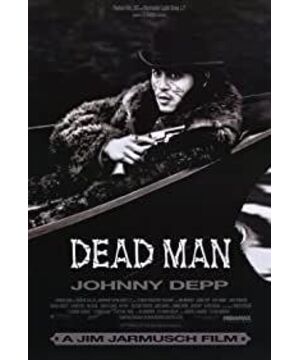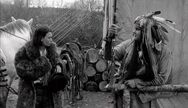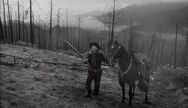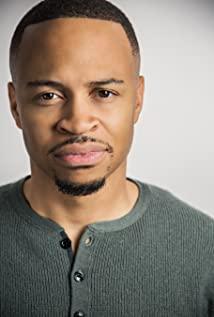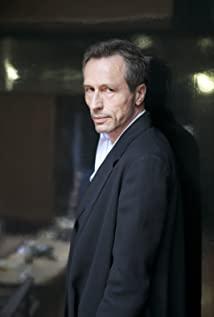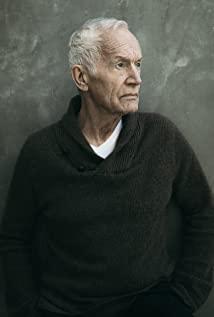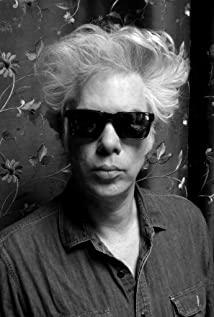The film begins with a convention, almost a cliché of a young man going out West to find his future. It takes place in the mid the late 1800s. (Kilpatrick, 170) At the time the western has been called a neo-western, a postmodern western, a parody of a western. (Kilpatrick, 169) It can well be imaged that there is no future for the young man William Blake (Johnny Depp) in the West. Deadman (1995) is a colorless, simple, and gloomy style movie. Black and white is the color tone of the movie. According to Dead Man Tells Tale: Tongues and guns in narratives of the West, the choice of black and white film is a strategy of stress and reframe its dominant narrative. If the Western myth is a technicolor myth, than Jarmusch's use of black and white is part of his demythologizing design. (Bromley, 52)
On the other hand, Dead man is a fable, which reflects a variety of colonial actions in the early period of America. Director Jim Jarmusch was trying to show vivid themes. Violence, intricate humanity, western colonialism, and redemption as the themes of the movie were given the multiple meanings. Jarmusch's production refreshes the audience mind by using different means of metaphors and symbolism to emphasize the theme violence, and by using the roles with complicate characteristics.
Dead man and Violence
Violence is a big theme in the film Dead man. Different angles have shown it. There is no smoothing over of violence, including the head squashing and cannibalism that even Jarmusch thinks might have been over the top. (Kilpatrick, 169) Dramatic images of death, and varies of metaphors and symbolism made the movie real.
From the macroscopic point of view, the categories of violence can be broken into the violence between whites and whites, the violence between whites and Indians, and the violence between humans and animals. Based on the plot, there is a conflict between William Blake and the manager of stealing factory, another conflict between the young accountant from Cleveland and his fiancée. When people had conflicts, they solved with guns. Shoot-out was common in the movie. In the scene of the killers and police chased William, and the priest who was selling the weapons and tobacco by the river, there are full of bullets and blood. The audiences could hear the sound of the violence. When William went through the small town, and the residents were starring him with hostility. He also threatens by the manager, and the man who in the corner of the street,they were silent violence. Artful metaphors were hidden in the violence between white groups. The image of white flowers and guns are the metaphor of the vulnerable woman and her angry fiancé. It is the comparison of soft and strong. Besides, White paper flower is a meaningful symbol of a woman. The white woman in the movie was selling the white paper flower. The feature of the paper is weak, which suggest the destiny of women in the late 1800s. More interestingly, white is a color, which represents holy and pure. It is the contrast to the character of the woman who slept with William Blake.White paper flower is a meaningful symbol of a woman. The white woman in the movie was selling the white paper flower. The feature of the paper is weak, which suggest the destiny of women in the late 1800s. More interestingly, white is a color , which represents holy and pure. It is the contrast to the character of the woman who slept with William Blake.White paper flower is a meaningful symbol of a woman. The white woman in the movie was selling the white paper flower. The feature of the paper is weak, which suggest the destiny of women in the late 1800s. More interestingly, white is a color , which represents holy and pure. It is the contrast to the character of the woman who slept with William Blake.
Except the violence between whites, the film shows the violence between whites and Native Americans in the side angle. In the movie, there were not any war image and blood image of killing Native Americans. Jim Jarmusch only shot the fire and ruined houses, and ash of the tribe, the declining indigenous villages. He repeated those images with sad background music. The broken houses and ash are the symbol of the violence. Thirdly, the film underlines the violence between humans and animals. It is shown from the beginning of the movie, people were shooting buffalos on the train. In addition, there are some animals' furs, like bear fur, in the manager's office, and there is a dead deer lying in the middle of the forest. These scenes are full of sarcasm . People killed each other as kill animals and slaughtered animals as conquerors.The movie indicates the decaying of industrial modern civilized world by underlining the violence. It also questions the white people that the definition of truly civilized, and stimulate people to reflect on their morality.
Dead Man and Characters
Dead Man was successful to use the contradictory characters. All the characteristics are both absurdity and reasonable. From the setting, we can see Jarmusch is unique and independent. He is not one to wait for anything, or to do anything in any way, but the way he wants. (Kilpatrick, 169) Dead Man created the characters that show full angles of humanities, and a different stereotype of Native Americans.
No matter William Blake (Johnny Depp) or Nobody (Gary Farmer), their characteristics, are complicated. There are absolute good or bad. The characters of white are different from the characters like Ethan Edwards (John Wayne) in The Searches (1956) who is typical for heroism, or John J. Dunbar (Kevin Costner) in Dance with the Wolves (1990) who are kind and brave. William Blake is not a typical hero. He has his fear, and weak side. He surrendered to violence , desensitized to violence, in order to defend. He showed the madness side in front of the hopeless situation. By contrast, he remained the pure side, stimulated by his Indian friend Nobody, and he eager to be redeemed.
Again, the stereotype of Native Americans was renewed successfully in the movie. “In regards to Dead Man, I just wanted to make an Indian character who wasn't either A) the savage who must be eliminated, the force of nature that's blocking the way for industrial progress, or B) the noble innocent that knows all and is another cliché. I wanted to be a complicated human being,” saying by Jarmusch. (Kilpatrick, 169) The character Nobody is created follow by this idea. He had the experience that leave the hometown to England, learn to be “civilized,” and then back to his own tribe. He was treated as a stranger, an outsider, which distinguishes between from indigenous people. Thanks to the education he accepted from England. His return to the original, and dressed in a traditional Indians way is more like a choice.His wisdom is more logical and evolutional. Not like the chief's foreknow character in the Little Big Man (1970), he does not have the ability to recognition, and he is not immortal. He could not save William's life, but he could save William's mind---an allegorical ritual. The elaborate and ceremonial ritual of preparing for death, not only speaks against the death-defying and death-denying repressions of Western culture but also proposes a design for another heroic project-other than that of the frontier dream-the recognition of, and resignation to, human transience that leads to ethical and ecological awareness of the negativities of violence and conquest. (Bromley, 56)He could not save William's life, but he could save William's mind---an allegorical ritual. The elaborate and ceremonial ritual of preparing for death, not only speaks against the death-defying and death-denying repressions of Western culture but also proposes a design for another heroic project-other than that of the frontier dream-the recognition of, and resignation to, human transience that leads to ethical and ecological awareness of the negativities of violence and conquest. (Bromley, 56)He could not save William's life, but he could save William's mind---an allegorical ritual. The elaborate and ceremonial ritual of preparing for death, not only speaks against the death-defying and death-denying repressions of Western culture but also proposes a design for another heroic project-other than that of the frontier dream-the recognition of, and resignation to, human transience that leads to ethical and ecological awareness of the negativities of violence and conquest. (Bromley, 56)human transience that leads to ethical and ecological awareness of the negativities of violence and conquest. (Bromley, 56)human transience that leads to ethical and ecological awareness of the negativities of violence and conquest. (Bromley, 56)
To sum up, Dead man is a unique landscape in the western movies. It is plenty of paradoxes, ambiguous metaphors, which are signatures of Jim Jarmusch can be found in his other productions. Although there are some negative voices claimed that Dead Man has been referred to as cinematic history's longest death scene. People Magazine's Tom Gliatto says it “goes on and on, one static, cute-weird scene after another.” Many of audiences are support its abstruse themes, exotic background music, absurd plot and its aesthetics of violence. Once is definitely not enough for this film. (Kilpatrick, 169)
Work Cited
Bromley, Roger “Dead Man Tells Tale: Tongues and guns in narratives of the West.”
EJAC. 20(1). 50-64.
Kilpatric, Jacqueline. Celluloid Indians: Native Americans and Film. University of
Nebraska Press. Lincoln and London. 1999.
View more about Dead Man reviews


